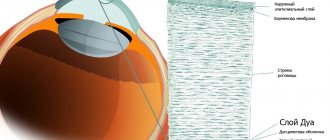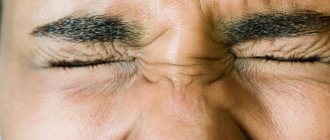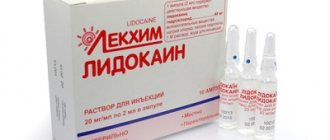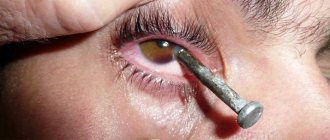Varieties
A chemical burn of the eyes is one of the types of injuries to the organs of vision that occurs as a result of exposure to the mucous membrane of aggressive chemicals in liquid, solid or vapor form. The substances listed below can act as a chemical agent.
Alkalis
They pose a serious danger to the organs of vision, affecting the deep-lying structures of the eye. The higher the pH level, the more severe the injury will be. Most often, alkali damage results from exposure to the following agents:
- ammonia;
- caustic potassium;
- barium;
- ethanol;
- lime.
Acids
When the eyes are exposed to acidic agents, only the external structures are affected, so the consequences are less dangerous. However, such injuries severely damage the cornea, causing decreased vision. Chemical burns to the organs of vision can be caused by the following acids:
- sulfuric;
- nitrogen;
- hydrofluoric;
- salt;
- nitrite;
- vinegar
Chemical burns to the eyes can be of an industrial or household nature.
Sometimes a chemical burn to the eye is diagnosed after eyelash extensions.
Why does a burn occur?
Chemical eye damage occurs when contact with substances such as:
- glue for eyelashes or silicate;
- household chemicals containing alkali and acids (Domestos, Grass, Arena, Pro Service, washing powders);
- kitchen cleaner;
- battery fluid (electrolyte) for the carburetor, which contains sulfuric acid;
- acid detergent with nitric acid;
- vinegar essence;
- solvent for oil paint;
- aerosols: air fresheners, gas cans, deodorant sprays;
- bleaching powder.
Return to contents
Symptoms
A chemical burn to the eye manifests itself with a clear clinical picture that cannot be ignored. When the conjunctiva is damaged by chemicals, severe pain occurs and the following symptoms are observed:
- burning, cutting;
- tearfulness;
- photophobia;
- swelling, hyperemia of the eyelids;
- swelling of the cornea;
- redness of the eyeball;
- blurred vision.
Damage to the organs of vision by alkali or acid causes a feeling of severe discomfort, a feeling of a foreign object or sand in the eyeball, due to which the patient cannot open his eyes normally. Often there is a decrease in the quality of vision. The clinical picture may vary depending on the severity of the injury:
- Mild degree. There is hyperemia of the eyelids and conjunctiva, swelling of the epithelium and sometimes erosion of the cornea. The prognosis is favorable, healing is rapid
- Average degree. Accompanied by swelling and hyperemia of the eyelids and conjunctiva, superficial clouding of the cornea and small blisters.
- Difficult stage. It is characterized by necrotic changes in the skin of the eyelids and conjunctiva, the cornea becomes cloudy, and the conjunctiva becomes covered with a scab. Most of the eye is affected and is often combined with cataracts and iridocyclitis.
- Particularly difficult stage. All tissues of the eyeball are affected, deep necrosis and charring of the sclera are observed. Perforation of the cornea, secondary glaucoma, and uveitis often occur.
Often, a chemical burn is accompanied by damage to the skin, on the surface of which multiple small blisters form.
Common manifestations of chemical eye burns
Decreased visual acuity
. The initial decrease may be caused by epithelial defects, opacity, increased lacrimation, or discomfort. For moderate to severe chemical burns, vision may be good immediately after the injury if the corneal clouding is slight. But over time, the effects of burns can become more pronounced and lead to significant vision loss.
Increased intraocular pressure (IOP)
. An immediate increase in IOP may occur due to deformation, shortening of collagen in the anterior chamber and trabecular apparatus. In the future, it may be associated with inflammation in the anterior part of the eye.
Inflammation of the conjunctiva
. Various degrees of hyperemia and swelling of the conjunctiva are possible even with mild damage. Additionally, the color of the conjunctiva may change: when exposed to chromic acid, the color is brown, and when exposed to nitric acid, it becomes yellowish.
Fragments of foreign substances in the conjunctival fornix
. Often occurs when the eyes are affected by particles of a solid substance, such as plaster, etc. If the particles are not removed, the chemical will continue to be released and the chemical burn will worsen. These particles must be removed before surface restoration can begin. Carbide and lime are especially dangerous. They should be removed before rinsing, without delaying the start of assistance, otherwise the substance will be dissolved by the liquid part of the tear, causing severe damage.
Perilimbal ischemia
. The degree of perilimbal ischemia (blanching) is an important predictor of future corneal recovery, since limbal germ cells are responsible for the renewal of the corneal epithelium. In general, more severe ischemia indicates a poorer prognosis.
Corneal epithelial defect
. The degree of damage to the corneal epithelium can vary from mild diffuse punctate epithelial keratitis to complete absence of epithelium. In the case of a complete absence of epithelium, the defect may be poorly stained with fluorescein, in contrast to ordinary erosion; moreover, such a defect may not be noticed. If an epithelial defect is suspected but not identified during the initial examination, the eye should be examined later after several minutes or even hours.
Possible consequences
A chemical burn to the eye is a serious injury that can cause blindness. The consequences of exposure to chemicals on the organs of vision can be very diverse and largely depend on the type of aggressive agent. An acid burn leads to severe pain that can provoke a painful shock, but with timely assistance there are no negative consequences. The most dangerous are alkaline injuries, as they change the structure of the eye and provoke tissue death, increasing ophthalmotonus.
Regardless of the type of aggressive substance, the following primary complications may occur as a result of injury:
- swelling of the cornea;
- conjunctivitis;
- perforation of the cornea;
- cataract;
- inflammatory processes;
- acute increase in ophthalmotonus.
A few days or weeks after a chemical burn, the following negative consequences may appear:
- secondary cataract or glaucoma;
- scarring of the conjunctiva;
- ulceration or vascularization of the cornea;
- phthisis.
Read in a separate article: Eye burns from quartz and ultraviolet lamps: what to do
With a chemical burn, visual acuity decreases and vision loss is possible.
If first aid was provided immediately, visual functions can usually be restored.
DO YOU STILL FIND THAT IT'S HARD TO GET CLEAR VISION BACK?
Judging by the fact that you are now reading these lines, victory in the fight against blurred vision is not yet on your side.
Have you already thought about surgery? This is understandable, because the eyes are very important organs, and their proper functioning is the key to health and a comfortable life. Sharp pain in the eye, clouding, dark spots, sensation of a foreign body, dryness or, on the contrary, watery eyes. All these symptoms are familiar to you firsthand.
But perhaps it would be more correct to treat not the effect, but the cause? We recommend reading the story of Yuri Astakhov, what he recommends doing. Read the article >>
One of the most common occupational injuries to the visual organs is a chemical burn to the eye. Aggressive chemicals when interacting with the conjunctiva or cornea cause severe discomfort and, in the absence of proper first aid, can lead to loss of vision and disability.
First aid
First aid should be provided immediately after the accident occurs. Immediately after the incident, it is necessary to carry out the following PMP algorithm for chemical eye burns:
- Rinse your eyes well with saline solution or plain clean water. It is recommended to do rinsing not under running water, but to fill a container with warm water, lower your face into it and blink vigorously. This action should be performed for at least 20 minutes.
- In case of a chemical burn with acid, it is recommended to use a soda solution or potassium permanganate for washing.
- The effect of an alkaline agent can be neutralized with a 2% acetic acid solution.
- If there are foreign particles in the eye, they must be carefully removed.
- To eliminate pain, you should take a painkiller.
After this, you need to apply a sterile bandage to the sore eye and send the victim to the doctor. In order for the ophthalmologist to select the most effective treatment, it is recommended to take with you a bottle of the damaging substance.
Treatment of chemical eye burns
Treatment of chemical eye injuries may include therapeutic modalities and rehabilitation surgery to maximize vision preservation both acutely and in the long term.
1) removal of the damaging agent
Direct copious rinsing remains the single most important method of eliminating chemical burns and treating them in the initial stages. If available, the eye should be anesthetized before irrigation. Local anesthetics are used to reduce pain, blepharospasm and to improve patient cooperation.
Ideally, the eye should be flushed with a sterile balanced buffer solution, such as normal saline or Ringer's solution. However, immediate irrigation with plain tap water (or still drinking water from a bottle, etc.) is preferable to waiting for the “perfect liquid.”
2) control of inflammation
Inflammatory mediators released at the time of injury cause cell necrosis and attract other participants in the ongoing inflammatory process in the tissues of the eye. This potent inflammatory response not only inhibits reepithelialization but also increases the risk of corneal ulceration and perforation.
Controlling inflammation through topical steroid use can help interrupt this inflammatory cycle.
Additionally, citrate or ascorbic acid (which changes calcium metabolism in the burn area) can be used. Acetylcysteine (10% or 20%) - may inhibit collagenolysis, which prevents the formation of corneal ulcers, but clinical use is currently controversial.
3) acceleration of restoration of the surface (epithelialization) of the eye
Full epithelialization cannot begin until the damaging chemical is completely removed. Chemical damage to the eye after a phase of reactive increase in tear production subsequently leads to a gradual decrease in tear production, and therefore moisturizing drugs (artificial tear preparations, etc.) play an important role in healing.
Ascorbic acid plays a fundamental role in restoring collagen structure, leading to improved corneal recovery.
Using medicated bandage contact lenses until epithelialization is complete may be beneficial in some cases.
Among the methods of surgical care, if necessary, the following are used: - partial removal of areas of necrotic conjunctiva or superficial tissues of the cornea; - temporary covering with amniotic membrane; — limbal stem cell transplantation; — transplantation of cultured corneal epithelial stem cells; - elimination of conjunctival symblepharon (fusion of the conjunctiva of the eyelids with the conjunctiva of the eyeball).
For the purpose of rehabilitation of visual functions, the following can be performed: - penetrating or partial keratoplasty, with or without simultaneous cataract extraction if necessary; — keratoprosthetics.
4) prevention of infection
In the absence of corneal epithelium, the eye is susceptible to infection. For prophylactic purposes, local antibiotics are used in the initial stages of treatment.
Special cyanoacrylate adhesive for ophthalmic use can be used to treat small, deep lesions of the corneal tissue.
5) control of intraocular pressure
With increased intraocular pressure, both at the initial stage of therapy and during the late recovery period, the use of intraocular fluid production blockers to reduce IOP is pathogenetically more justified.
Antihypertensive (penetrating antiglaucoma) surgery or surgery using shunt/valve devices may be performed when IOP elevation persists with the use of adequate topical antihypertensive medications. The period is determined individually.
6) Pain control
Serious chemical burns can be long lasting and extremely painful. Ciliary muscle spasm can be controlled using cycloplegic drugs; however, oral pain medications may be required initially.
Drug treatment
What to do if your eyes are burned by chemicals? After first aid has been provided, it is necessary to contact an ophthalmologist, even if the condition has improved significantly. After a thorough diagnosis, the doctor will assess the severity of the injury and select the appropriate treatment. For chemical burns to the eyes, the following medications may be prescribed:
- antibiotics: Tsipromed, Floxal;
- disinfectant drops: Levomycetin, Sofradex;
- corticosteroids: Betamethasone, Maxitrol;
- analgesics: Alcaine, Inocaine;
- anti-inflammatory drugs: Indocollir, Dexamethasone;
- mydriatics: Cyclomed, Irifrin;
- corneoprotectors: Korneregel, Solcoseryl gel.
In difficult cases, there is a need for surgical intervention. For chemical burns of 2, 3 and 4 degrees, hospitalization is required.
Probable forecast
Overgrowth of an eyesore after a burn
Prognosis for burn injuries to the eyes is determined by the nature and severity of the injury. The urgency of the specialized medical care provided and the correctness of drug therapy are important.
In case of severe injuries, a cataract usually forms, the conjunctival plane becomes overgrown, visual function decreases and complete atrophy of the eyeball with complete loss of vision. After a successful outcome of treatment after an eye burn, the patient is observed by a specialist for a year.
What not to do?
In case of chemical burns to the eyes, first aid should be provided to the victim as quickly as possible, and then contact an ophthalmologist. You cannot delay in providing pre-medical care, as the consequences of this can be extremely serious. In case of such an injury, it is strictly prohibited:
- rub your eyes;
- puncture blisters;
- use eye drops for chemical burns;
- apply healing agents without washing the eyes;
- treat damage with alcohol.
If damage to the organs of vision is caused by quicklime or sulfuric acid, then do not rinse your eyes with water. It is also prohibited to use drops if there is a chemical burn to the eyes from glue.
Prevention
Chemical burns to the eye are most often of an industrial nature, so the main measure to prevent such a serious injury is compliance with safety precautions. When working with chemicals, be sure to wear safety glasses. At home, it is also necessary to protect your eyes when using hazardous chemicals and always study the instructions and composition in detail before you start using an aggressive product. If there are small children in the house, then all household chemicals should be stored out of their reach.
If an aggressive substance gets into your eyes, you should immediately consult a doctor.
Author of the article: Kvasha Anastasia Pavlovna, specialist for the website glazalik.ru Share your experience and opinion in the comments.
Complications
Primary complications include: conjunctivitis, corneal erosion, corneal opacification and edema, acute increase in IOP, corneal melting and perforation.
Secondary complications may be: • secondary glaucoma; • secondary cataract; • scarring of the conjunctival cavity; • thinning of the cornea, perforation; • corneal ulcer (aseptic or infectious nature); • complete disruption of the surface, clouding and vascularization of the cornea; • subatrophy of the eyeball (phthisis).
Author
: Ophthalmologist P. S. Zaitsev, Kovrov, Russia.
Date
of publication (update): 01/31/2019











